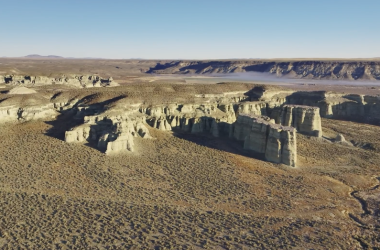A proposed gold mine in Malheur County moved closer to breaking ground at a public meeting on Thursday with state and federal regulatory agencies.
The Grassy Mountain mine, located about 20 miles south of Vale in eastern Oregon, would be the first chemical-process gold mine in the state. Gold in sites like Grassy Mountain is not concentrated in chunks or veins like many people imagine when they think of gold mining. Instead, it is fairly evenly distributed through the rock in tiny pieces that have to be separated with a solvent in a process called cyanidation. This process uses one of two forms of cyanide, which critics say could harm workers and the surrounding environment.
The Nevada-based companies behind the project, Calico Resources, and its parent company Paramount Gold say the mine would bring 270 jobs and $10 million in annual wages to the area and generate $15 million a year in taxes. But opponents worry about the environmental cost of the mine, fearing the cyanide could pollute the groundwater. Cyanide blocks the body’s ability to use oxygen, leading to lung injury, coma and death in both humans and wildlife.
Oregon has a long history of gold mining, but today has few gold mines, with Nevada producing about three-quarters of the gold in the U.S. as of 2022. And globally, only about 5% of all gold mined comes from the U.S.
Calico and Paramount started the permit application process in 2017. In May 2019, Malheur County’s planning commission voted unanimously to approve the permit, beginning the current process with state and federal agencies.
Those agencies have to issue a variety of permits for the operation to start, dealing with water use and quality, wildlife impact and more. If officials do not require any drastic changes to the current plan, there would be a two-year construction period followed by about seven years of mining that could produce about $700 million in gold.
Thursday’s meeting was the latest technical review of the project by officials from the Department of Environmental Quality, Fish and Wildlife, Water Resources and more, along with federal agencies, including the U.S. Fish and Wildlife Service and the Bureau of Land Management. The review process is led by the main mine permitting agency in the state, the Oregon Department of Geology and Mineral Industries.
The state has contracted with Stantec, an international consulting company with an office in Portland, to produce two reports to guide the rest of the permitting process: one on the environmental impact and one on the socioeconomic impact on the region. Both reports are expected to be done later this summer.
Thursday’s meeting established a few important guidelines to keep the permitting process in motion. State and federal officials voted to limit the environmental evaluation to a study area around the mine and the road between the mine and the town of Vale, rather than a larger area, as some members of the team had suggested. They also discussed details in the socioeconomic report.
That socioeconomic report will be the first outside confirmation of the economic promises that Calico and Paramount have made to Malheur County. Median household income in the county is under $48,000, and company projections expect 150 construction jobs and 120 longer-term mining and administration jobs, at an average wage of almost $80,000, a major infusion of high-paying jobs into a county that struggles to attract large employers.
“It will be an incredible economic boon and diversify the economy of Malheur County,” State Sen. Lynn Findley, R-Vale, a longtime supporter of the project, told the Capital Chronicle. “Malheur is predominantly an agriculture-based county, and this will add a natural resource component to it that I think will be a good thing. I’m pretty excited about it.”
The law that governs the regulatory process passed the Oregon Legislature in 1991, and although officials have started the permitting process for mines before, this is the first time a chemical-process mine has been close to being approved. One reason that Calico and Paramount’s plan has come this far is the near-record high price of gold, now at almost $2000 per ounce.
“The question is, is Oregon open for business for chemical-process mining? It has regional scope,” said Randy Jones from the Oregon Department of Environmental Quality, and a member of the team that met Thursday
In a statement released Wednesday, the Oregon chapter of the Sierra Club voiced its opposition to the project, calling gold mining “a dirty business and highly disruptive of the natural and human environment.” The statement also cited worries about Indigenous rights, energy use and worker safety. The area is traditional Northern Paiute land.
In early May, a joint comment on the project by the environmental groups Oregon Natural Desert Association and the Northwest Environmental Defense Center concluded that “the proposal to use chemical processing poses significant risks to water quality, wildlife habitat, recreational, cultural and aesthetic values and resources.”
One possible compromise to reduce potential contamination was brought up in Thursday’s meeting. Though cyanidation is used in about 90% of gold mining around the world, there are alternatives that do not use cyanide. Part of Stantec’s environmental report will include information on whether these alternative methods are realistic for this project, and how they would affect the economics and viability of the mine.
The technical team meets next in late summer.The companies have not released a set date for when they plan to start construction, if final permits go through.
Oregon Capital Chronicle contributor Ian Rose is a freelance science and nature writer based in Corvallis, Oregon.
Oregon Capital Chronicle is part of States Newsroom, a network of news bureaus supported by grants and a coalition of donors as a 501c(3) public charity. Oregon Capital Chronicle maintains editorial independence. Contact [email protected]. Follow Oregon Capital Chronicle on Facebook and Twitter.




